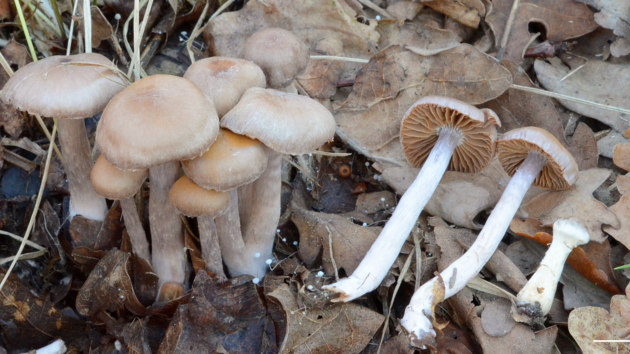Unexplored diversity
As for the species of mushrooms that have been described and "approved" by scientists so far, there are over 150,000 of them. However, experts estimate that there may be between 2 and 4 millions of fungi worldwide.
And these are quite conservative estimates
– says Prof. Izabela Kałucka.
In recent years, publications have been published in which new calculations based on molecular tests appear. The results of these studies say that there may be up to 11 million species of mushrooms in the world! And this puts mushrooms in an equal rank with animals in terms of diversity. Interestingly, scientists are still discovering new species (up to 2,000 species a year!).
It is not easy, because it may take even several years to prove the discovery and describe it. The majority of new discoveries concern microscopic fungi, new species of the so-called macrofungi, i.e. forming fruiting bodies which are visible to the naked eye, are much more seldom. Prof. Kałucka has so far discovered three such species of fungi and is working on the next ones, the discovery of which she intends to publish soon.
During the research in the Stołowe Mountains National Park and during the research of post-reclamation areas in the vicinity of Bełchatów, I managed to discover completely new species of higher fungi of the Cortinarius genus.
– says Prof. Kałucka.
It wasn't easy, because Cortinarius is the most numerous genus of macrofungi in the world in terms of species. We know almost 3,000 species of this mushroom, so recognition is not easy. Often only molecular studies show that we are dealing with a completely new species.
Why do we need mushrooms?
It appears that not only for consumption purposes. The popular and recognisable Boletus edulis, Cantharellus cibarius and Suillus luteus that we use in the kitchen are only a small part of the huge variety of the mushroom kingdom. In the kitchen, yeast is also useful – it has been used for centuries to bake bread and for fermentation. Meanwhile, just as higher fungi are just a part of all mushrooms, their widespread use in the kitchen is only one and not the most important function.
Without mushrooms, there would be no forests. Fungi help trees to absorb water and mineral salts from the soil. Recently, it has also been found that fungi are responsible for the acquisition of nitrogen compounds bound in organic matter by trees, which they would not be able to obtain themselves. The symbiosis of trees with fungi is an obligatory phenomenon – if a tree seedling does not find its mycorrhizal partner, it simply will not grow. This is one of the reasons why, when planting forests on reclaimed, heavily transformed or very polluted areas, tree seedlings are inoculated together with appropriate fungi. Then the risk that the forest planting process may fail is much lower.
– assures Prof. Izabela Kałucka.
Mushrooms also live in symbiosis with some animal species such as ants, termites and beetles. Together with symbiotic bacteria, they also help ruminants digest food. We should also remember that lichens are fungi that form close relationships with algae and cyanobacteria. In turn, parasitic fungi, by eliminating weakened, sick or old individuals from the population of plants and animals, contribute to keeping them as a whole in good condition and regulate their numbers. However, fungi are primarily responsible for the decomposition of dead organic matter: wood in the form of branches, logs, stumps, litter composed of fallen leaves, needles, fragments of bark, dead shoots of herbaceous plants, etc., or excrement and animal remains. Thanks to the process of decomposition and mineralisation of organic compounds, they enable their reuse by plants and participate in maintaining soil fertility. Thanks to the ability to decompose even very durable and toxic substances, they can clean the environment of hard-to-degrade pollutants.
Mushrooms will not grow in a pot
Edible mushrooms are those species of mushrooms that have a proven value as food ingredients and are used for culinary purposes, most often because of their great taste, aroma or texture. Interestingly, only a small part of the edible species is grown by man. They include champignons, oyster mushrooms, mun and shitake mushrooms.
We can grow them because they are saprotrophic fungi, using dead organic matter, on a substrate that humans are able to provide them with.
– explains Prof. Kałucka.
However, Boletus edulis, Suillus luteus or Leccinum will not grow in a pot or even in a professional hall for the production of mushrooms. Why? Because they are symbiotic mushrooms, which, in order to produce fruiting bodies, must be in a relationship with their symbiotic host, in the natural environment, i.e. in the forest.
Mushrooms are dying
One can be tempted to say that if there are no mushrooms, forests will also die.
It should be remembered that due to the huge number of mushroom species and their diversity, when one species dies, its ecological functions can be taken over by another species. The tree does not cooperate with only one mycorrhizal species, there are often several or even several dozens of them. The question is how far we can simplify these systems and how long the ecosystem will endure this simplification. When we cross this barrier, we will face a catastrophe.
– explains Prof. Kałucka.
In our ecological responsibility, we should also ask ourselves whether we can afford the extinction of certain mushroom species. We don't even know them well. A dying species may be replaced in the environment by another, but it may also turn out that we have irretrievably lost the source of a substance that could be used, for example, in medicine.
Among the rare mushrooms there are species that have strong pharmacological. Laricifomes officinalis, also known as agarikon, is one of such mushrooms. It has been used in folk medicine for centuries. Today it turns out that it has documented anti-cancer properties. It occurs in Poland only in six locations and is a species under strict protection. It is threatened with extinction not only in Poland – it is an endangered species on a global scale. Research on the use of common mushrooms in modern medicine is also carried out – promising properties are shown, for example, by the Fomitopsis betulina, commonly known as the birch polypore. It has antibacterial, antiviral, anti-inflammatory, anticancer and immunostimulating properties.
– emphasises Prof. Kałucka.
Recently, a drug for multiple sclerosis has been available.The drug is also based on substances derived from mushrooms. The value of its sales in the world now reaches $2.5 billion a year. There are many species of mushrooms containing substances that we do not know much about and we do not know if and how they could be useful to humans. However, these few examples are enough to conclude that we cannot afford to irretrievably lose species of fungi, including those that we don't know yet.
Identification, examination, conservation
In order to protect, you need to know what to protect. Therefore, it is necessary to be able to identify species – knowledge of taxonomy and recognition methods. It is also necessary to know about the ecological and habitat requirements of fungi, as well as about their occurrence and distribution.
Scientific research is necessary during which we learn about the relationships between different organisms, between organisms and their environment. Thanks to this, we learn how to protect their habitats. We see, for example, how climate change, pollution, falling groundwater levels or elements of forest and spatial management negatively affect fungal populations. The question is whether we can take protective measures and ensure the durability of habitats necessary for various groups and species of fungi to survive.
– says Prof. Kałucka
The document which contains information about which species of mushrooms are endangered are the fungal red lists. There are such lists in dozens of countries. There is also a Global Red List, which lists species that are endangered on a global scale.
However, it must be remembered that this document is getting old. The list reflects the level of our knowledge at the time of its publication, but both the threats and the level of our knowledge about how a given factor can harm fungi and which species are affected by these threats change. In some cases, the threat may cease when the threat factor is eliminated or mitigated. On the other hand, we obtain knowledge about other species whose populations or the number of sites is declining under the influence of existing factors and which meet the criteria qualifying them for the red list. In other words, it is a dynamic document and needs to be updated from time to time.
– emphasises Prof. Kałucka.
In Poland, the first edition of the red list of macrofungi, indicating the threat to over 800 species, was published in 1986 and it was one of the first such documents in the world. The next edition appeared in 1992 and the last one in 2006.
These dates indicate that a new list should urgently appear, especially since the evaluation criteria set by the World Conservation Union have changed. However, for this you need a group of specialists who will devote their time to update the list. Unfortunately, this work is not much appreciated, funded, or translated into the scores by which we are judged as scientists.
– Prof. Kałucka.
Mushrooms that are protected in Poland – a priceless monograph
Recognising the great need for its implementation, mycologists, especially those from the Polish Mycological Society, the Diversity and Conservation of Fungi Section, chaired by Prof. Kałucka, collect data and prepare to evaluate the risk of fungi in Poland according to the current criteria.
Thanks to the efforts of 20 authors and a large number of collaborators – professional and amateur mycologists, last year we managed to publish the long-awaited monograph "Grzyby chronione Polski. Rozmieszczenie, zagrożenia, rekomendacje ochronne" [Mushrooms protected in Poland. Distribution, threats, conservation recommendations], which summarises the current knowledge about 117 species of fungi under legal protection in our country. I hope that we will also be able to publish an update of the fungal red list, which will probably include over 1,000 species of mushrooms at risk of extinction in Poland.
– says Prof. Kałucka, co-editor of the work.
Source: Faculty of Biology and Environmental Protection, University of Lodz
Edit: Justyna Kowalewska (3PR Consulting)
Photos: Izabela Kałucka


